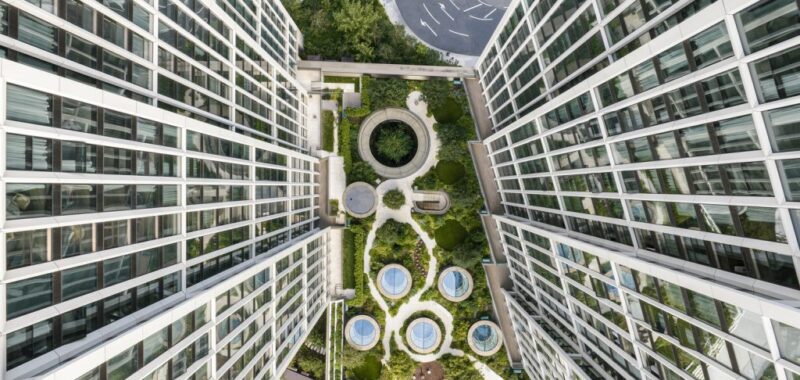Alfred Hitchcock’s penultimate (and most violent) movie, 1972’s Frenzy – captures a lost London. Set largely in Covent Garden, it shows the area – these days a tourist trap – as it had stood for the previous 300 years – a bustling flower and fruit market. At the time of the filming, Sir Robert McAlpine was already busy at work across the River Thames at Nine Elms, building a new home for the market, with traders moving south in 1974. Now the market is being relocated once again, and the vacated New Covent Garden is the scene of a new frenzy of construction activity.
The four-hectare site is being redeveloped into a mixed-use scheme branded Thames City, made up of 12 residential and commercial buildings ranging in height from four to 53 storeys, set around a linear park. Earlier this year, phase one was completed. This phase consists of 526 luxury apartments across two residential towers, and a 50,000 sq ft podium/basement plus public green space.
Thames City was initiated by a joint venture of two Hong Kong developers, CC Land and R&F. It is now being developed by Excel Winner, controlled by CC Land. But the name of the main contractor – Midgard, a subsidiary of the JRL Group (itself only the 27th biggest construction firm in the UK) – might come as a surprise.
The origins of the current scheme can be traced back to 2012, when architectural firm Skidmore, Owings & Merrill was commissioned to create a masterplan for the redevelopment of New Covent Garden Market. The vision was to create a vibrant urban quarter that would integrate seamlessly with the broader Nine Elms regeneration, which included significant transport infrastructure improvements, including the extension of the Northern Line to a rejuvenated Battersea Power Station.
The search for a main contractor began in earnest in 2018, as the developers sought a company capable of handling the vast scope of the Thames City project. Initial discussions tier one contractors including Skanska, McAlpine, and Mace, came to naught, according to Steve McGuckin, global head of client programmes at Turner & Townsend. “They all said, ‘we’re not going to lump sum this but we’ll do management contracting or construction management’. And of course, the Asia mentality is, you get a lump sum.”
Turner & Townsend, which acted as project and cost manager on the build, turned toward residential specialists. And it soon became clear that the answer to their prayers was very close at hand. Midgard was already contracted to carry out works on the basements on the scheme. “Given there was a relationship already there, and because the Asian market have a close relationship with the contractor, over a period we managed to negotiate a lump sum design and build approach,” McGuckin says.
By 2019, a letter of intent was in place. The job suited Midgard/JRL’s recently-adopted strategy. In 2017, it had bought McMullen Facades out of receivership with a view to working on residential towers. “That was our kind of preferred market,” says, Kevin Keegan, director at JRL Group. Nonetheless, the Thames City job represented a jump in scale for the contractor. At north of £400m, the contract was worth more than double the size of the company’s previous biggest job.
The company’s integrated approach and its ability to offer direct labour via the wider JRL Group only increased the appeal to the client. During ensuing Covid pandemic, it meant that a unified health and safety policy allowed work to continue with minimal disruption. “Of course, in 2019 you didn’t know the pandemic was coming. A year later, it looked like inspired decision making, but in reality, it was about that relationship that was already there,” McGuckin says.
Once the enabling works were complete, Midgard began work on the three towers that would define the Thames City skyline. One of the key innovations introduced by Midgard was the establishment of an on-site concrete batching plant. This decision proved to be a game-changer, allowing the construction team to produce concrete on demand and ensure a steady supply throughout the project. The ability to control the supply of concrete minimized the risk of delays due to traffic or external supply chain issues.
“If you’re making your own concrete, you can control your own programme,” says Keegan. “Multiplex was building number one Nine Elms just up the road. If we were both trying to pull on the same day out of a third-party batching plant, we would both potentially end up being disappointed.”
By the time the contract was formally signed in September 2020, much of the building’s frame was already up, with façade work partially-completed by external specialist Yuanda and many modular bathroom pods manufactured by Stone Bathwear in place. “That gave us a good run of work to go out on the internal fit out,” Keegan says. “We subcontract most of the finishing trades in the way that most of the market would, but the real drivers of program, structure, facade, MEP, drywall, we have those in house. Those are the engine room.”
Thames City is more than just a collection of residential towers; it is designed to be a new kind of luxury residential experience. The three towers are connected by a shared podium that houses a range of amenities, including a swimming pool, gym, private dining areas, and a karaoke room. This podium serves as the heart of the development, providing residents with access to hotel-like amenities. The crown jewel within the first phase is a penthouse, a luxury apartment spread across five floors, marketed at a cool £38m.
For Midgard and parent JRL, the completion of phase one of the scheme shows it can compete with the biggest players in the residential market. Further success would be represented by continuing the relationship it has built with the client and landing the forthcoming next phase of the scheme.

